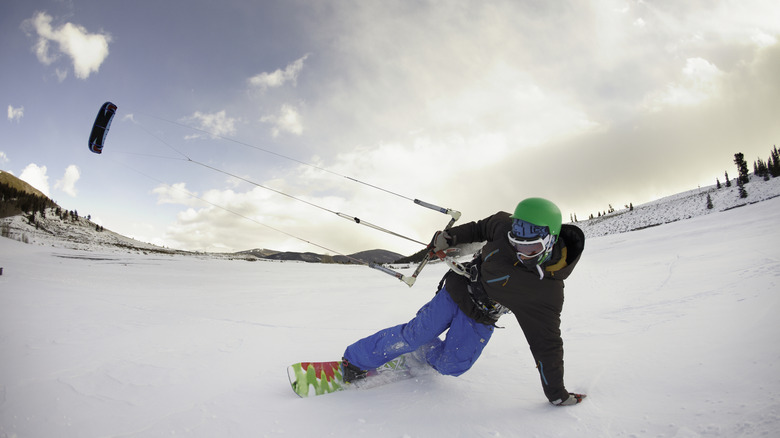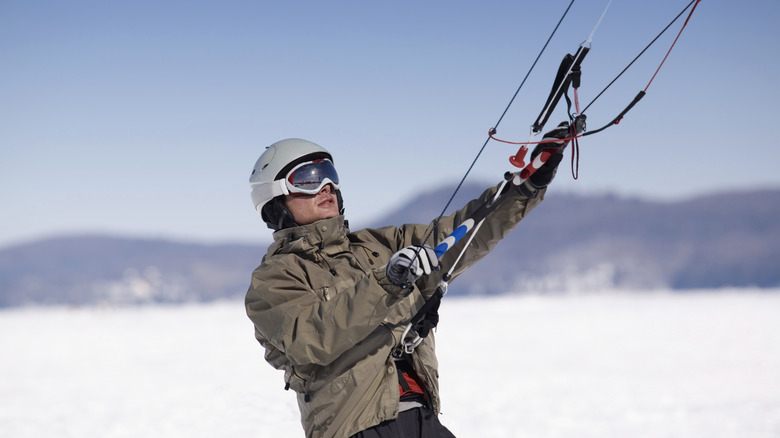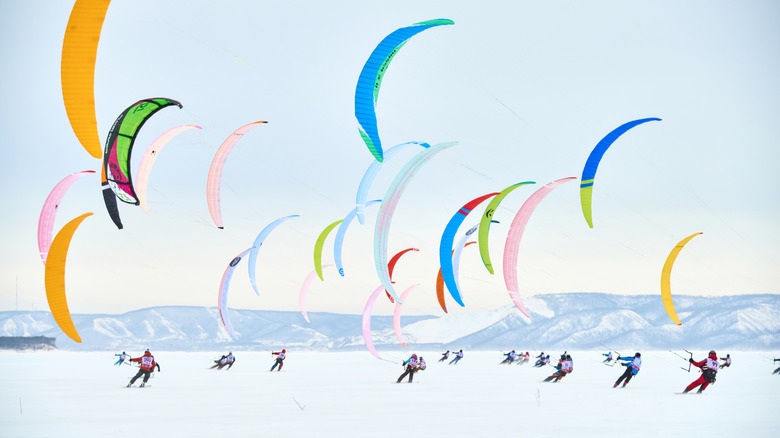Try Snowkiting This Winter For A Chance To Soar Across The Powder
We may receive a commission on purchases made from links.
A field of fresh snow tends to bring out the kid in many of us. When it comes to playing in the snow, kids are notorious for coming up with new ways to experience it. Thanks to some intrepid adults listening to their inner child, a relatively new winter sport is on the rise – snowkiting, which is a creative way to quickly propel across snowy fields and slopes.
Very similar to the sport of kiteboarding (which is practiced over water), snowkiting utilizes a large kite to pull a person along over snowy surfaces. The sport can be practiced on either snow skis, referred to as kite skiing, or a snowboard, which is known as kiteboarding, just as its watery cousin, or simply snowkiting. It's said that both forms of snowkiting are actually easier to pick up than kiteboarding on water.
Proponents of the sport tout what they believe are an endless array of advantages. Beyond the ease of learning to snowkite, the cost of entry is relatively low. This is particularly true if one is already an active snowboarder or snow skier, as much of that equipment can be utilized for snowkiting. Additionally, because snowkiting can be practiced in a variety of settings, it is considered a low-risk activity, unless you choose to take on high-risk challenges. So, if you enjoy spending time on the snow, you should certainly try the thrilling sport known as snowkiting.
What do you need to start snowkiting?
A huge benefit of the sport is that much of what you need to start snowkiting is the same gear you need to start snow skiing or snowboarding. If you aren't currently a snow skier or snowboarder, the first step is to choose a snowboard or pair of skis. Then, you need to get the appropriate safety equipment, such as ski goggles and a helmet, like the OutdoorMaster Kelvin Ski Helmet. Additionally, you will need the same clothing layers, gloves, and outerwear, like a waterproof ski bib and ski jacket.
While that gear will get you on the slopes to ski or snowboard, you will obviously need a kite in order to snowkite. Kites are available in both inflatable and foil models. Additionally, kites come in a variety of sizes. Choosing the right size of kite involves matching the size to the wind conditions. A five square meter kite is a fairly standard size that is meant to handle wind speeds ranging from 14 to 20 miles per hour. When the wind is above 20 miles per hour, a smaller kite is needed. Conversely, a larger kite is advantageous for lower wind speeds.
You will also need a control bar and kite lines. As the name suggests, the control bar is used to control the kite. The kite lines connect the control bar to the kite. The HQ4 HQ Rush V Pro 350 Trainer Power Kite bundle is a simple way to get this additional equipment, as it includes not only the kite, but also the control bar and kite lines. It also comes with a snowkiting instructional video that can help you learn the sport.
Where can you snowkite?
One of the biggest advantages to snowkiting is it can be done pretty much anywhere there is an adequate layer of snow. As long as there is ample wind, snowkiting can be done, whether the terrain is flat, hilly, or mountainous. Snowkiting is also done on frozen lakes. Essentially, anywhere that is suitable for snow skiing, snowboarding, or ice skating can be utilized for snowkiting.
While experienced snowkiters can ply their craft in a variety of areas, when you are starting out, it is important to find an area that allows for safe learning and practice with minimal risks. While you are getting the hang of snowkiting, try to find a wide open space that is free of obstacles such as poles or trees. Areas that are flat or have very gently rolling hills and consistent wind are ideal. Entry level snowkiters should follow the same safety tips for first-time snow skiers, which include things such as dressing properly, wearing helmet and safety gear, watching out for others, and following all rules and regulations.
As you progress and gain a greater degree of skill, you can attempt snowkiting in more challenging areas. Some of the activities snowkiters take part in include speed riding over frozen lakes, cliff jumps, freestyle aerial tricks, and mountain descents. There are also events such as the Red Bull Ragnarok race in Norway. However, many snowkiters continue to enjoy casual rides over snowy fields and hills. The ability to choose the level of difficulty and type of terrain you wish to snowkite is yet another advantage of the sport.


